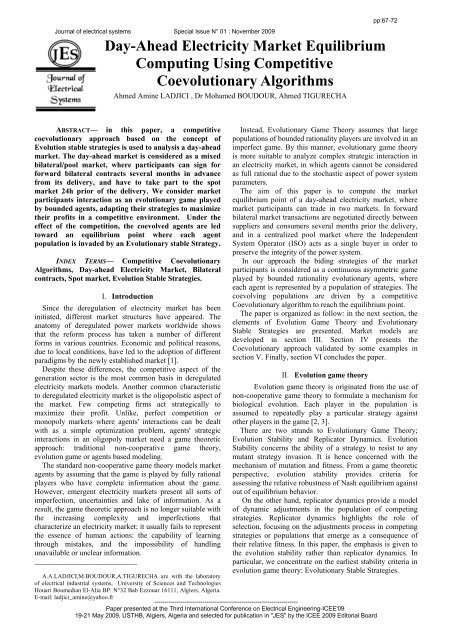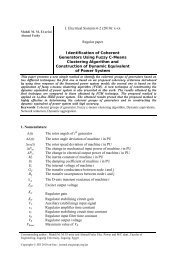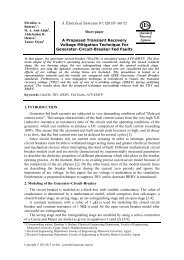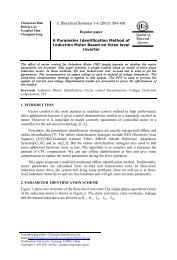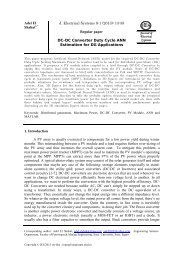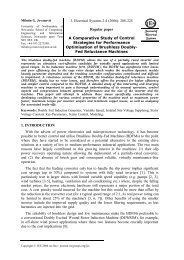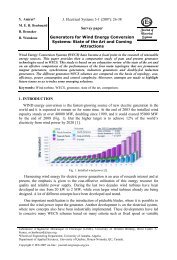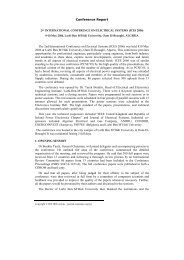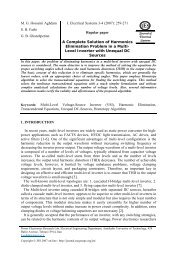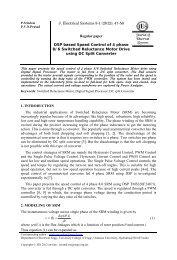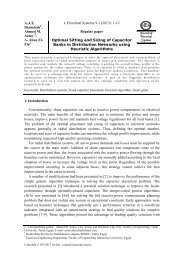Effect of Aluminium Layer on Induction Heating Control Case Study ...
Effect of Aluminium Layer on Induction Heating Control Case Study ...
Effect of Aluminium Layer on Induction Heating Control Case Study ...
Create successful ePaper yourself
Turn your PDF publications into a flip-book with our unique Google optimized e-Paper software.
Journal <str<strong>on</strong>g>of</str<strong>on</strong>g> electrical systems Special Issue N° 01 : November 2009For comparis<strong>on</strong> purpose, we use 03 cases studies:1- In the first case market, agents compete in thebilateral forward market <strong>on</strong>ly.2- In the sec<strong>on</strong>d case, agents compete in the spot market<strong>on</strong>ly.3- In the third case, agents compete in both markets.Table 2: C<strong>on</strong>sumers demand functi<strong>on</strong> parametersC<strong>on</strong>sumer0 eD i0 eiD i$/MWh C<strong>on</strong>sumer i$/MWhMWhMWh1 62.5 1.00 11 50.0 0.902 40.0 0.80 12 40.0 0.803 50.0 0.80 13 50.0 1.004 75.0 1.00 14 50.0 1.005 60.0 0.90 15 37.5 0.706 50.0 1.00 16 25.0 0.607 60.0 1.00 17 25.0 0.908 40.0 0.70 18 40.0 0.809 25.0 0.60 19 37.5 0.8010 40.0 0.80 20 50.0 1.001) Bilateral future electricity market equilibriumIn this case, we c<strong>on</strong>sider a bilateral future c<strong>on</strong>tractsmarket where exchanges are made directly between suppliersand c<strong>on</strong>sumers. In this paper, we assume that each supplierhas a portfolio <str<strong>on</strong>g>of</str<strong>on</strong>g> clients, for instance we assume that eachsupplier has 06 clients, and each c<strong>on</strong>sumers has <strong>on</strong>e or moresuppliers. Suppliers’ portfolio is depicted <strong>on</strong> Table 3, eachsupplier has 6 c<strong>on</strong>sumers randomly chosen.Table 3 locati<strong>on</strong>s <str<strong>on</strong>g>of</str<strong>on</strong>g> Suppliers’ clients.Locati<strong>on</strong> <str<strong>on</strong>g>of</str<strong>on</strong>g> c<strong>on</strong>sumers (bus)1 2 3 4 5 6supplier 1 9 18 5 14 11 6supplier 2 10 8 12 1 4 7supplier 3 8 3 13 11 15 16supplier 4 17 20 14 19 3 15supplier 5 6 9 19 4 1 13supplier 6 7 2 16 5 18 12To compute the market equilibrium, we use the proposedcompetitive coevoluti<strong>on</strong>ary algorithm the results are reported<strong>on</strong> Tables 4 and 5.Table 4: Suppliers’ equilibrium pointquantities c<strong>on</strong>tracted (MWh)1 2 3 4 5 6Supp 1 9.27 7.33 13.24 10.44 10.39 9.94Supp 2 9.95 6.83 5.49 11.83 15.89 10.12Supp 3 8.80 11.12 9.42 9.75 7.78 6.93Supp 4 9.26 13.08 7.73 5.77 9.85 6.45Supp 5 8.67 8.45 6.69 18.18 13.86 8.75Supp 6 14.55 11.64 7.86 14.04 7.99 8.93Table 5: C<strong>on</strong>sumers’ load and price at equilibrium pointD PD PC<strong>on</strong>sumer MWh $/MWh C<strong>on</strong>sumer [MWh] [$/MWh]1 25.69 36.81 11 20.13 33.182 11.64 35.45 12 14.42 31.983 20.97 36.29 13 18.17 31.834 34.08 40.92 14 18.18 31.825 27.28 36.36 15 14.23 33.246 18.61 31.39 16 14.79 33.687 24.66 35.34 17 9.26 34.168 15.63 34.81 18 15.32 30.859 17.72 37.13 19 12.47 31.2910 9.95 37.57 20 13.08 36.922) Spot market EquilibriumIn the sec<strong>on</strong>d case, we c<strong>on</strong>sider that agents make bids inthe spot market <strong>on</strong>ly. We assume that suppliers submit linearaffine supply functi<strong>on</strong> to the ISO who performs an OPF tocompute the quantity and price to be dispatched to eachsupplier. By using the proposed algorithm, the spot marketequilibrium is reported <strong>on</strong> table 6.Table 6 Suppliers’ equilibrium point in spot marketx [$/ MW 2 i h]Pg [MWh]Price[$/MWh]supplier 1 0.11 177.15 51.47supplier 2 0.16 129.67 51.50supplier 3 0.13 154.07 51.51supplier 4 0.16 126.75 51.52supplier 5 0.13 159.85 51.51supplier 6 0.08 200.00 51.523) Day-ahead electricity market equilibriumIn this case study, agents take part <strong>on</strong> both bilateralforward market and spot market. Using the developedcompetitive coevoluti<strong>on</strong>ary algorithm, we compute theEquilibrium point <str<strong>on</strong>g>of</str<strong>on</strong>g> the mixed bilateral/pool market. Theobtained results are shown <strong>on</strong> Tables 7, 8 and 9.Table 7 Suppliers’ optimal strategies in the bilateral marketquantities c<strong>on</strong>tracted (MWh)1 2 3 4 5 6Supp 1 2.76 0.00 4.67 0.00 1.16 0.00Supp 2 0.00 1.56 0.00 3.64 7.93 2.81Supp 3 1.35 2.63 0.00 1.53 0.36 1.50Supp 4 0.00 0.00 0.00 0.00 3.11 0.56Supp 5 0.00 3.11 0.01 7.99 4.22 0.00Supp 6 3.04 0.00 1.46 4.39 0.00 0.00Table 8: C<strong>on</strong>sumers’ load and price at equilibrium pointC<strong>on</strong>sumerD PMWh $/MWh C<strong>on</strong>sumer D PMWh $/MW1 7.86 54.64 11 2.69 52.562 0.00 50.00 12 0.00 50.003 5.74 55.33 13 0.00 50.004 15.91 59.09 14 0.00 50.005 9.07 56.59 15 0.92 52.266 0.00 50.00 16 2.97 53.397 5.85 54.15 17 0.00 44.448 2.91 52.98 18 0.00 50.009 5.86 56.9 19 0.01 46.8610 0.00 50.00 20 0.00 50.00-----------------------------------------------------------------------Paper presented at the Third Internati<strong>on</strong>al C<strong>on</strong>ference <strong>on</strong> Electrical Engineering-ICEE'0919-21 May 2009, USTHB, Algiers, Algeria and selected for publicati<strong>on</strong> in "JES" by the ICEE 2009 Editorial Boardpp:67-72
Journal <str<strong>on</strong>g>of</str<strong>on</strong>g> electrical systems Special Issue N° 01 : November 2009VII. BIBLIOGRAPHY[1]. Pinto, L. and Szcrupak, J., An Evoluti<strong>on</strong>ary Game Approach toEnergy Markets, IEEE Proceedings <str<strong>on</strong>g>of</str<strong>on</strong>g> Internati<strong>on</strong>al Symposium <strong>on</strong>Circuits and Systems, ISCAS, Vol. III., pp 324-27, 2003.[2]. Samuels<strong>on</strong>, L, Evoluti<strong>on</strong> and Game Theory, Journal <str<strong>on</strong>g>of</str<strong>on</strong>g> Ec<strong>on</strong>omicPerspectives, Volume 16, Number 2, Spring, 47–66., 2002.[3]. Crawford, V.P, Theory and Experiment in the Analysis <str<strong>on</strong>g>of</str<strong>on</strong>g> StrategicInteracti<strong>on</strong>, Invited Symposium Lecture at the Ec<strong>on</strong>ometric SocietySeventh World C<strong>on</strong>gress, Tokyo, 1995.[4]. Maynard Smith, J., Evoluti<strong>on</strong> and the Theory <str<strong>on</strong>g>of</str<strong>on</strong>g> Games, CambridgeUniversity Press, ISBN 0-521-28884-3, 1982.[5]. Ireland, N.J., Evoluti<strong>on</strong>arily Stable Strategies: who does the mutanthave to beat?, Department <str<strong>on</strong>g>of</str<strong>on</strong>g> Ec<strong>on</strong>omics, University <str<strong>on</strong>g>of</str<strong>on</strong>g> Warwick, UK,2006.[6]. Cressman, R., C<strong>on</strong>tinuously Stable Strategies, NeighborhoodSuperiority and Two-Player Games with C<strong>on</strong>tinuous Strategy Space,Department <str<strong>on</strong>g>of</str<strong>on</strong>g> Mathematics. Wilfrid Laurier University Canada,2006.[7]. Cressman, R., Evoluti<strong>on</strong>arily stable strategies, prepared for the NewPalgrave Dicti<strong>on</strong>ary <str<strong>on</strong>g>of</str<strong>on</strong>g> ec<strong>on</strong>omics, 2nd Editi<strong>on</strong>, 2006.VI. CONCLUSION[8]. G. Stamtsis ‘Power transmissi<strong>on</strong> cost calculati<strong>on</strong> in deregulatedelectricity market’. PhD thesis, University <str<strong>on</strong>g>of</str<strong>on</strong>g> Duisburg-Essen,Germany, 2003.[9]. R. Baldick, Electricity market equilibrium models:The effect <str<strong>on</strong>g>of</str<strong>on</strong>g>parametrizati<strong>on</strong>, Department <str<strong>on</strong>g>of</str<strong>on</strong>g> Electrical and Computer EngineeringThe University <str<strong>on</strong>g>of</str<strong>on</strong>g> Texas at Austin,http:// users.ece.utexas.edu/~baldick/papers/parametrizati<strong>on</strong>.pdf.[10]. A.A Ladjici, M. Boudour, Electricity market equilibrium usingcompetitive coevoluti<strong>on</strong>ary algorithms with transmissi<strong>on</strong> c<strong>on</strong>straints,IEEE SSD 2008, 2008, pp 1—6[11]. Wiegand, R.P., An Analysis <str<strong>on</strong>g>of</str<strong>on</strong>g> Cooperative Coevoluti<strong>on</strong>aryAlgorithms, PhD Thesis, George Mas<strong>on</strong> University, 2003.[12]. Stanley, K.O. and R. Miikkulainen, Competitive Coevoluti<strong>on</strong> throughEvoluti<strong>on</strong>ary Complexificati<strong>on</strong>, Journal <str<strong>on</strong>g>of</str<strong>on</strong>g> Artificial IntelligenceResearch, 63-100, 2004.[13]. Johns<strong>on</strong> et al., Coevoluti<strong>on</strong>ary Optimizati<strong>on</strong> <str<strong>on</strong>g>of</str<strong>on</strong>g> Fuzzy LogicIntelligence for Strategic Decisi<strong>on</strong> Support, IEEE Transacti<strong>on</strong>s <strong>on</strong>Evoluti<strong>on</strong>ary Computati<strong>on</strong>, Vol. 9, No. 6. 2005.[14]. Service T et al., Infrastructure Hardening: A CompetitiveCoevoluti<strong>on</strong>ary Methodology Inspired by Neo-Darwinian ArmsRaces, 31st Annual Internati<strong>on</strong>al Computer S<str<strong>on</strong>g>of</str<strong>on</strong>g>tware andApplicati<strong>on</strong>s C<strong>on</strong>ference, COMPSAC, Vol.1., 101-104. 2007[15]. Rosin, C.D. and. Belew R.K, New methods for CompetitiveCoevoluti<strong>on</strong>, Evoluti<strong>on</strong>ary Computati<strong>on</strong>, Vol. 5, 1-29, 1997[16]. Bäck T. Evoluti<strong>on</strong>ary Algorithms and Their Standard Instances,Handbook <str<strong>on</strong>g>of</str<strong>on</strong>g> Evoluti<strong>on</strong>ary Computati<strong>on</strong>, Oxford University Press, ChB1.1, 1997.[17]. Mahfoud, S.W, Niching methods, Handbook <str<strong>on</strong>g>of</str<strong>on</strong>g> Evoluti<strong>on</strong>aryComputati<strong>on</strong>, Oxford University Press, ch. C6.1, 1997.[18]. Angeline, P.J. and J.B. Pollack, Competitive Envir<strong>on</strong>ments EvolveBetter Soluti<strong>on</strong>s for Complex Tasks, Proceedings <str<strong>on</strong>g>of</str<strong>on</strong>g> the FifthInternati<strong>on</strong>al C<strong>on</strong>ference <strong>on</strong> Genetic Algorithms, 1993.Table 9 Suppliers’ strategies and outcome <str<strong>on</strong>g>of</str<strong>on</strong>g> spot marketx [$/ MW 2 i h]D [MWh]Price[$/MWh]supplier 1 0.11 178.23 51.08supplier 2 0.15 133.85 51.08supplier 3 0.13 149.94 51.08supplier 4 0.16 127.97 51.09supplier 5 0.13 157.52 51.08supplier 6 0.08 200.00 51.09It is clearly observed from Tables 7 and 8 that in order toincrease their pr<str<strong>on</strong>g>of</str<strong>on</strong>g>it, suppliers should withdraw some <str<strong>on</strong>g>of</str<strong>on</strong>g> theirbids in the bilateral market and choose spot market whereprices are higher.This paper presents a new approach to find out themarket equilibrium in deregulated electricity markets using acompetitive coevoluti<strong>on</strong>ary algorithm based <strong>on</strong> the c<strong>on</strong>cept<str<strong>on</strong>g>of</str<strong>on</strong>g> Evoluti<strong>on</strong> Stable Strategies. In the latter, each agent isrepresented by a populati<strong>on</strong> <str<strong>on</strong>g>of</str<strong>on</strong>g> strategies and uses nestedevoluti<strong>on</strong> strategies as learning method to find the bestbehaviors to overcome opp<strong>on</strong>ents’ strategies.In our approach, we c<strong>on</strong>sider the day-ahead market as amixed bilateral/pool market, each agent acts strategically inorder to maximize his pr<str<strong>on</strong>g>of</str<strong>on</strong>g>it: it submits bids in terms <str<strong>on</strong>g>of</str<strong>on</strong>g>quantity to be sold in the bilateral forward market, and asupply functi<strong>on</strong> in the spot market in order to maximize itspr<str<strong>on</strong>g>of</str<strong>on</strong>g>it.To validate the proposed algorithm, an IEEE 30 bus testsystem is used as a case study. The proposed algorithm isapplied to analyze strategic behavior <str<strong>on</strong>g>of</str<strong>on</strong>g> market’s agents inboth bilateral forward market, spot market and day-aheadmarket. In the different cases c<strong>on</strong>sidered, the proposedalgorithm has succeeded in finding the ESS set and hencethe market equilibrium point. Furthermore, the obtainedresults show that suppliers’ strategic behavior increases themarket clearing price by withdrawing quantities to be sold inthe bilateral market to increase the market price and there fortheir pr<str<strong>on</strong>g>of</str<strong>on</strong>g>its.From the studied cases, <strong>on</strong>e can notice that the mainadvantage <str<strong>on</strong>g>of</str<strong>on</strong>g> the proposed approach is the possibility tohandle different market structures and pricing schemes,which makes it an appropriate simulati<strong>on</strong> and analysis toolfor deregulated electricity markets.pp:67-72-----------------------------------------------------------------------Paper presented at the Third Internati<strong>on</strong>al C<strong>on</strong>ference <strong>on</strong> Electrical Engineering-ICEE'0919-21 May 2009, USTHB, Algiers, Algeria and selected for publicati<strong>on</strong> in "JES" by the ICEE 2009 Editorial Board


